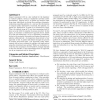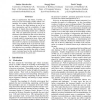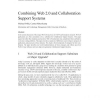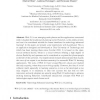ICWS
2010
IEEE
13 years 11 months ago
2010
IEEE
Abstract—Recently, mashups are gaining tremendous popularity as an important Web 2.0 application. Mashups provide end-users with an opportunity to create personalized Web service...
WS
2008
ACM
14 years 21 days ago
2008
ACM
The World Wide Web (WWW) can be seen as an ideal platform for enhancing argumentative expression and communication, due to its ubiquity and openness. Much argumentation takes plac...
UMUAI
2008
14 years 21 days ago
2008
This paper aims to demonstrate that the principles of adaptation and user modeling, especially social annotation, can be integrated fruitfully with those of the Web 2.0 paradigm a...
SIGIR
2008
ACM
14 years 22 days ago
2008
ACM
We present HAMLET, a suite of principles, scoring models and algorithms to automatically propagate metadata along edges in a document neighborhood. As a showcase scenario we consi...
MM
2010
ACM
14 years 1 months ago
2010
ACM
In Web 2.0, users have generated and shared massive amounts of resources in various media formats, such as news, blogs, audios, photos and videos. The abundance and diversity of t...
DGO
2009
14 years 1 months ago
2009
Impact assessment (IA) is a key method for the legislator to evaluate policies, norms or regulations currently under development. Experts use IA to gather and analyze input from m...
APCCM
2009
14 years 1 months ago
2009
Service-oriented architectures (SOAs) provide the basis of distributed application frameworks where software components are provided as modular and reusable services. Until today ...
LWA
2007
14 years 2 months ago
2007
Web 2.0 applications like Flickr, YouTube, or Del.icio.us are increasingly popular online communities for creating, editing and sharing content. However, the rapid increase in siz...
MC
2008
14 years 2 months ago
2008
In the current discussion of the impact Web 2.0 may have on CSCW and Groupware research, Web 2.0 applications are often considered to be a substitute for Collaboration Support Sys...
HCI
2007
14 years 2 months ago
2007
Web 2.0 is an emerging catch phrase and the applications associated with it shocked the traditional eLearning world. However, is this really all new and can it be considered suitab...




